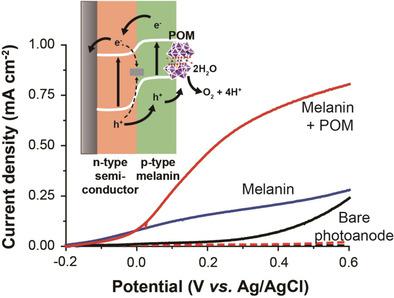当前位置:
X-MOL 学术
›
ChemSusChem
›
论文详情
Our official English website, www.x-mol.net, welcomes your feedback! (Note: you will need to create a separate account there.)
Semiconducting Synthetic Melanin‐Based Organic/Inorganic Hybrid Photoanodes for Solar Water Oxidation
ChemSusChem ( IF 8.4 ) Pub Date : 2018-09-06 , DOI: 10.1002/cssc.201801135 Cheolmin Lee 1 , Dasom Jeon 1 , Sanghyun Bae 1 , Hyunwoo Kim 1 , Yujin Han 1 , Yang Woo Lee 2 , Jungki Ryu 1
ChemSusChem ( IF 8.4 ) Pub Date : 2018-09-06 , DOI: 10.1002/cssc.201801135 Cheolmin Lee 1 , Dasom Jeon 1 , Sanghyun Bae 1 , Hyunwoo Kim 1 , Yujin Han 1 , Yang Woo Lee 2 , Jungki Ryu 1
Affiliation

|
We report the development of semiconducting melanin‐based organic/inorganic hybrid photoanodes for solar water oxidation. Synthetic melanin thin‐film incorporating polyoxometalate (POM) water oxidation catalysts (WOCs) are readily deposited on the surface of various n‐type inorganic semiconductors (e.g., Fe2O3, BiVO4, and TiO2) by electropolymerization. The deposition of melanin and POM hybrid (MP) thin‐film results in the remarkably improved performance of an underlying semiconductor photoanode for solar water oxidation with a significantly increased photocurrent density and decreased onset potential for water oxidation through the formation of a melanin‐based p–n heterojunction structure. We believe that this study can provide insights into the design and fabrication of various melanin‐based optoelectronic devices by utilizing its unique physicochemical properties.
中文翻译:

半导体合成的基于黑色素的有机/无机杂化光阳极,用于太阳能氧化
我们报告了用于太阳能水氧化的基于黑色素的半导体有机/无机杂化光阳极的发展。包含多金属氧酸盐(POM)的合成黑色素薄膜水氧化催化剂(WOC)容易沉积在各种n型无机半导体(例如Fe 2 O 3,BiVO 4和TiO 2)的表面上)通过电聚合。黑色素和POM杂化(MP)薄膜的沉积可显着改善底层半导体光阳极的太阳能水氧化性能,并显着提高了光电流密度,并通过形成基于黑色素的p降低了水氧化的起始电势。 –n异质结结构。我们相信,这项研究可以利用其独特的理化特性,为各种基于黑色素的光电器件的设计和制造提供见识。
更新日期:2018-09-06
中文翻译:

半导体合成的基于黑色素的有机/无机杂化光阳极,用于太阳能氧化
我们报告了用于太阳能水氧化的基于黑色素的半导体有机/无机杂化光阳极的发展。包含多金属氧酸盐(POM)的合成黑色素薄膜水氧化催化剂(WOC)容易沉积在各种n型无机半导体(例如Fe 2 O 3,BiVO 4和TiO 2)的表面上)通过电聚合。黑色素和POM杂化(MP)薄膜的沉积可显着改善底层半导体光阳极的太阳能水氧化性能,并显着提高了光电流密度,并通过形成基于黑色素的p降低了水氧化的起始电势。 –n异质结结构。我们相信,这项研究可以利用其独特的理化特性,为各种基于黑色素的光电器件的设计和制造提供见识。



























 京公网安备 11010802027423号
京公网安备 11010802027423号